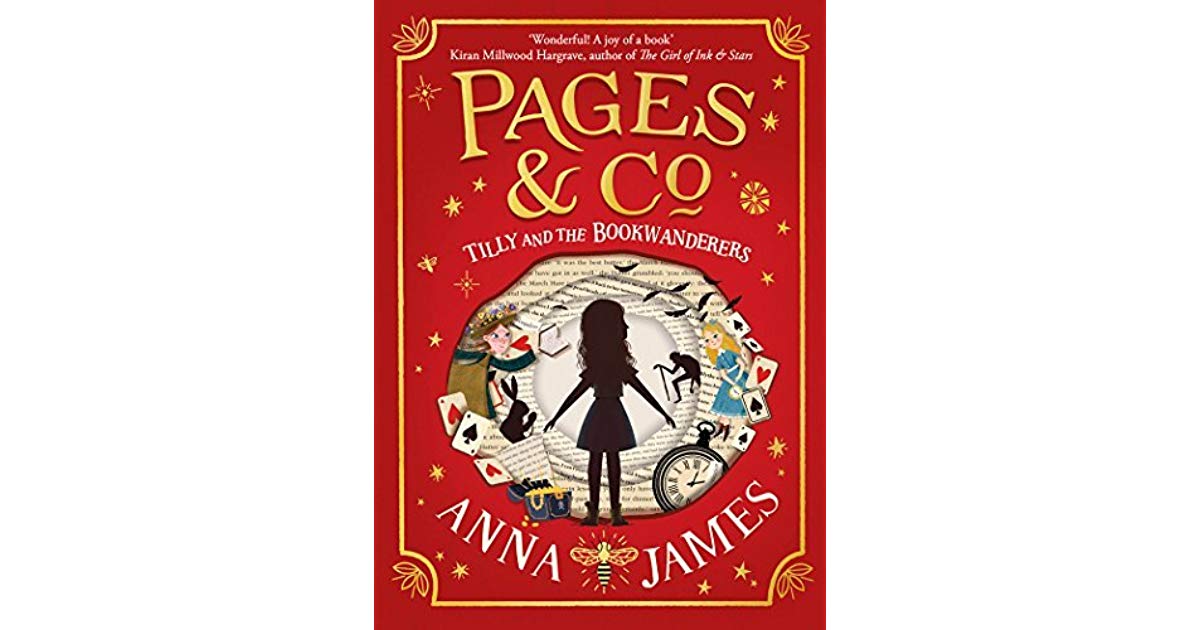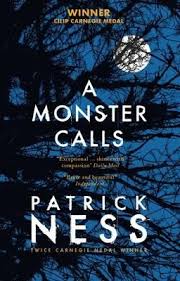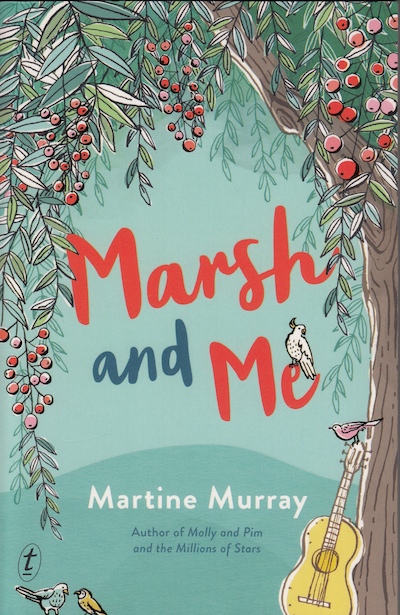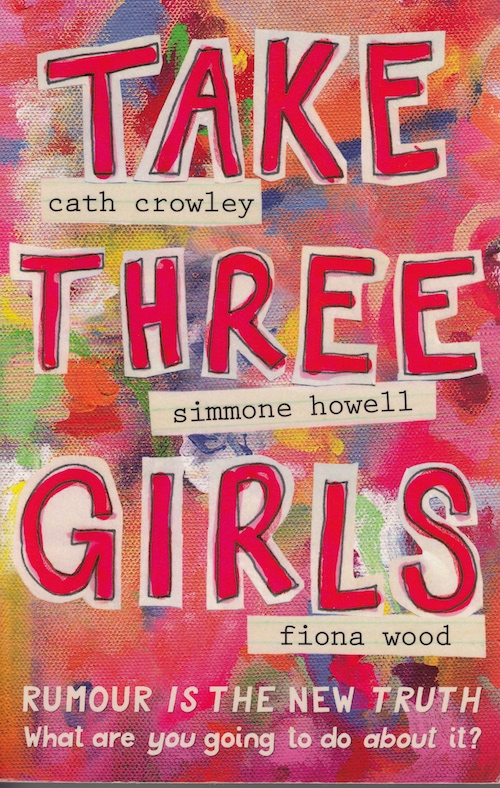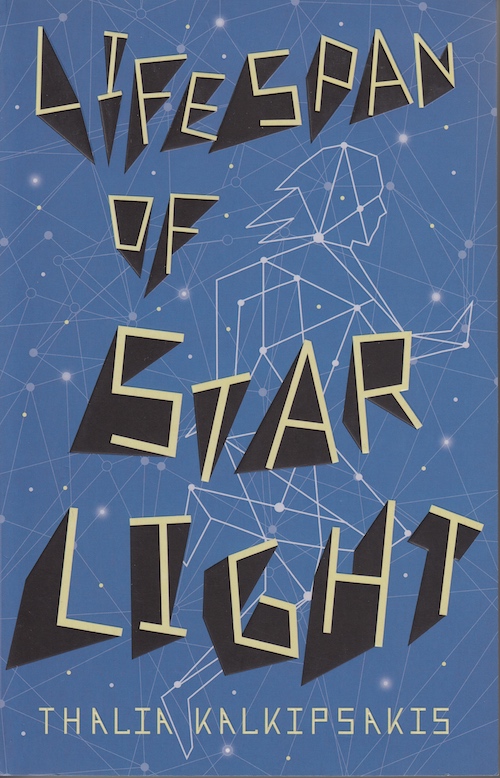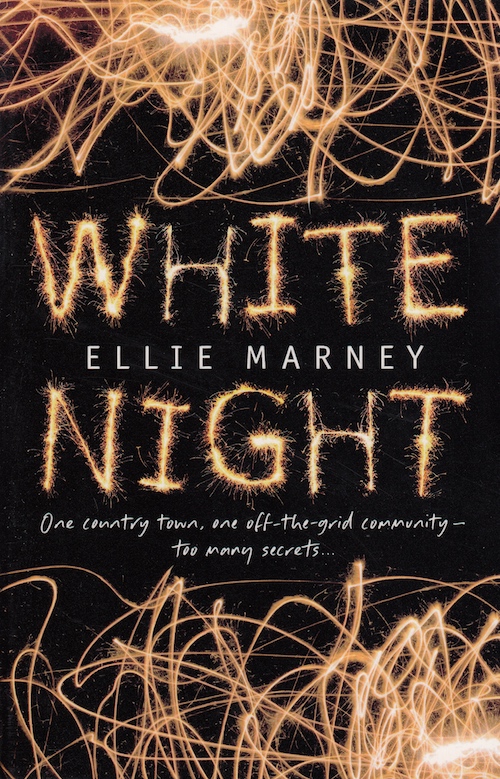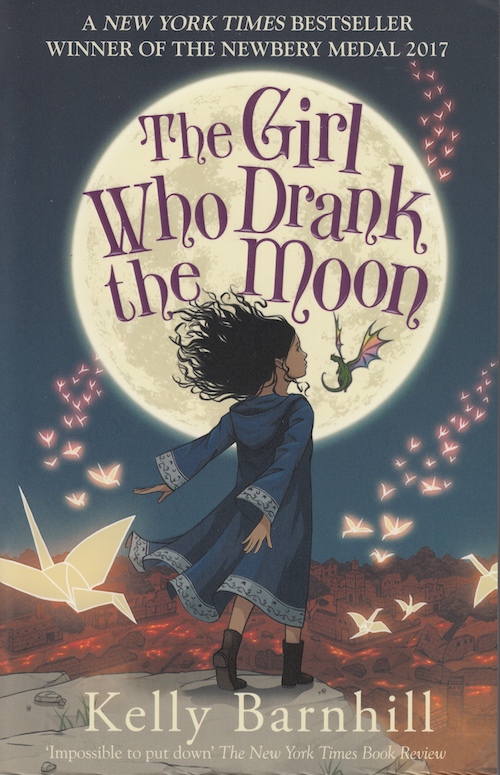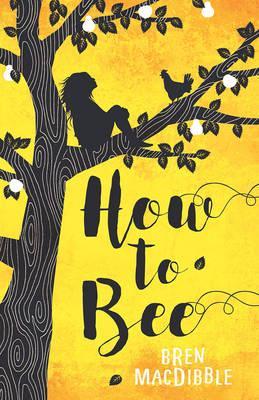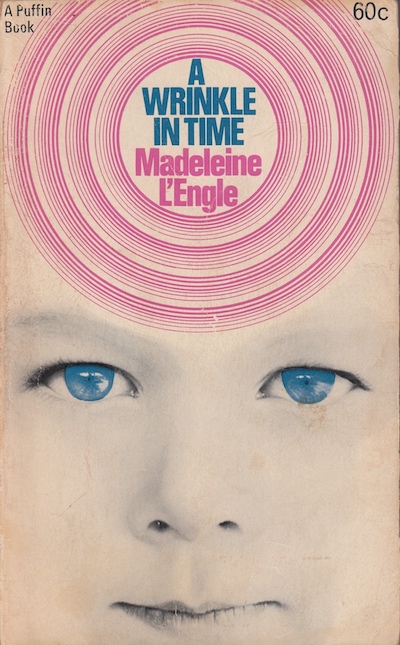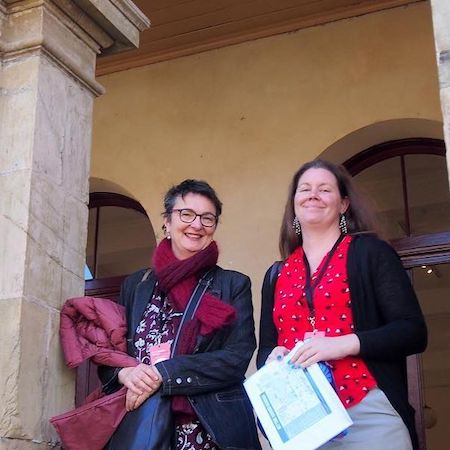 Bendigo Writer’s Festival this week. I spent all day there Friday and yesterday – listening, talking, meeting people. My brain is buzzing with ideas. A real winter boost for the soul, and so very, very enjoyable! I haven’t had time to muster my thoughts about all the sessions I attended, but I’ll do something I promised I would.
Bendigo Writer’s Festival this week. I spent all day there Friday and yesterday – listening, talking, meeting people. My brain is buzzing with ideas. A real winter boost for the soul, and so very, very enjoyable! I haven’t had time to muster my thoughts about all the sessions I attended, but I’ll do something I promised I would.
Which is to post my complete book list for ‘Green’s Guide to Good Books’. Wearing my (invisible) bookseller’s hat, I presented this session at the Friday schools’ day, called Text Marks the Spot, which is coordinated by La Trobe University Bendigo’s Sarah Mayor Cox. It was a full house in the Bendigo Bank Theatre at the Capital; attentive kids, excellent questions, a great host in Georgie Eberbach from Bendigo Secondary College (we’re pictured here in the portico of the Capital) and lots of fun.
I always madly over-prepare, so here’s the long version of what turned out to be a fast-moving and fun session.
Text Marks the Spot 2018 Green’s Guide to Good Books.
What’s a good book? Everyone’s got their own opinion. One you start? One you finish? Anything that interests you? Quality writing? Gripping story-telling? Gets on with it? Slow burn and takes its time? Cinematic and visual? Streamlined, quick and easy? Challenging? A book that you “get”? A book that “gets” you?
Once upon a time, a very long time ago, I was pretty snotty about what made a good book and would have excluded a lot of great reads. Because they were genre fiction, mainly. I’ve changed a whole lot. I think all sorts of books are “good” for all sorts of reasons. I’ve chosen (with help from Kathryn at Stonemans Bookroom where I work) 16 good books. Not all of them are exactly my cup of tea. Some I never would have read unless prodded into it. Some of them were really memorable, and have made we want to read more of that author. I’ve tried to vary the genre and style of book but I’m only one reader with one set of eyes. My aim is for you get some ideas from this selection. Maybe you’ll give something you wouldn’t normally read a try. I hope so!
We’re starting with the younger end of YA here. And I’d just like to say something about “reading down” – as in, reading books for a younger age group. I do it all the time. I read a lot of junior fiction, not just because I’m a bookseller and a writer, but because I genuinely enjoy reading it.
The plus for me is often that they are shorter! I think that a lot of books published now are just too long. They don’t always need to be. While sometimes I love to wallow in a long, long book, with beautifully realised time and place, exploring fully the characters past and present – not always. Sometimes I don’t have the time or more importantly, the concentration. I’m tired. I’m stressed. I’m busy. But I want to read! Many junior fiction or YA titles just get on with it. And sometimes, that’s what I need. I encourage you to occasionally look at junior titles – books that are down from your age group – and give them a go.
- A Wrinkle in Time by Madeleine L’Engle.
A Wrinkle in Time has recently been made into a movie. I haven’t seen it, so I can’t comment. But I know that re-reading this time, I actually want to keep my version of it in my head. Meg Murry’s scientist father is missing and Meg is having a hard time fitting in at school. The other children tease her about her father and her “dumb baby brother” and she can’t help lashing out. Everything seems dark and hopeless to Meg – until one stormy night, everything begins to change. Into her life comes a trio of odd guardian angels – Mrs Whatsit, Mrs Who and Mrs Which – and her new friend Calvin. Together with her brother Charles Wallace, they travel through a wrinkle in time to find her father.
- A Wizard of Earthsea by Ursula le Guin
This is an absolutely spell-binding fantasy novel. I hadn’t read it since I was about 12 or 13, and it’s even better than I remembered. It’s the classic story of young wizard Sparrowhawk. Through pride and ambition, he lets an evil shadow into the world…and it’s up to him to hunt it down and destroy it. An almost perfect book.
- A Drowned Maiden’s Hair by Laura Amy Schlitz
This title includes all the kinds of story elements that I love. Orphans, secrets, gaslamps, séances…It’s 1909, and Maud Flynn is an inmate of the Barbary Asylum for Female Orphans which is somewhere near Boston in the USA. She’s eleven years old, small for her age, clever and defiant and – according to the Superintendent, Miss Kitteridge, not the sort of little girl that anyone would want to adopt. But she’s wrong. She’s exactly what Miss Hyancinth Hawthorne is looking for. Maud loses her heart to the enchanting Hyacinth, and she’s overjoyed when she goes to live with her, her sisters and their rough but kindly servant, Muffet. But – of course – all is not as it seems. (How I love those words!)
Maud is a feisty, complex character; Miss Hyacinth is fascinating and the unfamiliar (to me) setting in 1900s America added a bit of extra interest to the ‘gaslight’ scene.
- How to Bee by Bren McDibble
I was completely bowled over by How to Bee. It’s the voice. And it’s almost always the voice. Peony is brave, funny, straightforward. Listen.
Today! It’s here! Bright and real and waiting. The knowing of it bursts into my head, so big and sudden, like the crack of morning sun bursting through the gap at the top of the door. I fall out of my bunk and hit the packing-box floor. I scramble up, right into Gramps asleep in his chair in front of the potbelly stove.
‘Cha!’ he growls.
‘Sorry Gramps,’ I say. ‘It’s bee day.’ I pull on my pest vest and try to squeeze past him, but he puts out his foot.
‘First eat, then bee,’ he says, real firm. He cuts a wedge from the oatcake on top of the stove.
Cockies screech loud from the tree over our shack. They know it’s time to get moving. ‘I can’t,’ I say and try to squeeze past again. ‘Foreman’s waiting.’
My sister, Magnolia, sticks her fluffy head out from the top bunk. ‘Stomp yourself, Peony-pest,’ she groans.
‘You won’t diz me when I’m a bee,’ I say.
This is a world where all the bees have died. Brave and nimble children have to climb the fruit trees to pollinate the flowers by hand. Pests are picked by hand, too – that’s why Peony is wearing a pest vest – but Peony has set her heart on being a bee. However, her mother, who works in the city, has other plans for her daughter. Big themes and ideas, deceptively simple writing. It so deserves to be on the CBCA shortlist.
- Marsh and Me by Martine Murray
As I’ve said, I really, really like books that aren’t too long! It’s great to find a satisfying read that isn’t a marathon. Short doesn’t have to mean simple, just as simple language can tell a complex story. How to Bee is one example. So is Martine Murray’s Marsh and Me.
Joey Green is a good kid. He’s kind and smart and funny, but just not the sort of boy who gets noticed. He’s kind of hesitant. He lacks confidence. He’s so scared of failure that he doesn’t try. He plays guitar and would love to take part in The Battle of the Bands – he’d like to be friends with some of the kids at his school – but his doubts are holding him back.
At school, there’s a footy match on at lunchtime. The guys are all playing, except for me and Digby. Digby is watching a trail of ants. So he isn’t talking. I am sitting in the sun, half watching the guys, half wishing I was one of them, half glad to be just sitting there and not showing how bad I am at ball stuff. I know that’s a lot of halves, but that’s what it’s like inside my mind. It doesn’t add up neatly.
When he meets Marsh – a most unusual girl in a tree house – Joey’s life begins to change. This is a gentle, thoughtful book about friendship, music, taking chances, risking failure – and above all, how you can enter into the mysterious inner lives of other human beings.
- Take Three Girls by Fiona Wood, Simmone Howell and Cath Crowley
Moving in to a different age group now – this is older YA, perhaps from 14 onwards. Take Three Girls is a collaboration between 3 well-known YA writers, Simmone Howell, Fiona Wood and Cath Crowely. They take three very different girls and combine their stories.
We have Ady. She’s the cool girl from a rich family, but neither the cool or the family are quite as they appear to be. Then there’s Kate, the academic over-achiever, expected to be a doctor, whose passion is for experimental music. And Clem, the swimming star who’s lost heart for her sport.
The girls are in year 10, and they’re taking part in a Wellness Program at their posh private school, St Hilda’s. They’ve all been smeared by PSST, a misogynistic cyber-bullying website. The Wellness Program and what flows on from it – and what they do about PSST – forms the story. This is really, really good YA fiction, just as you’d expect from three such expert authors. It’s compelling, funny, raw, romantic, sexy, occasionally disturbing (Note: language, sexual content!). It’s narrated by each girl in a variety of ways, including through their wellness journals. I love the device of the Wellness Program, because it allows for jolts of introspection without slowing the story down. So many questions get to be raised… Who am I? Am I happy? How well do we really know each other? How might we change our thinking about others? What I want to be? Is belonging the same as fitting in? Do I have to do what I’m expected to do? What is being true to yourself? What is being brave?
Dear Journal,
I like the idea of this but I’m not calling it a Wellness journal. That makes it sound like I’m in some kind of formal therapy, which I fully support if you need it, but I’d rather think of it as a kind of diary.
Am I happy with my identity?
If you’d have asked me before I came to St Hilda’s I would have said pretty much. Now I don’t know. I don’t know a lot of things since I moved to the city. My life plan’s gone out of whack…
My life plan had been in place for a while. Study hard. Convince mum and dad to send me to St Hilda’s, where I would study even harder…work like crazy to get into medicine. Become a doctor. Pay mum and day back. Look after them and the farm…
It’s as though, on the day I heard Frances Carter (musician) my self changed. A part of me that I didn’t know existed spoke for the first time. It makes me wonder what else is there waiting to appear
Expect to explore issues of friendship, honesty, courage, love & sexuality. Empathize, sympathize, laugh – even cry – as well.
- Lifespan of Starlight by Thalia Kalkipsakis
Lifespan of Starlight is #1 in a trilogy by Thalia Kalkipsakis. It was first published in 2015, and actually slipped by me then. It’s speculative fiction, Sci-Fi – and deals with time travel – the ability to move around into the future. As we begin the book, the future is now – it’s 2084, Melbourne. Unequal, surveilled, grimy and run-down, with food and water rationed, and every citizen is supposed to be chipped so that each aspect of their lives – where they go, what they do, how much they spend – is monitored. One day, in a park in Footscray, an unchipped, illegal teenager called Scout makes a shocking and gruesome discovery. Soon, she and two friends are pushing the limits of what’s possible. The authorities are closing in. Are they desperate enough to risk everything they know? This novel is speedy and exciting, with superior world-building. #2 is Split Infinity and the 3rd instalment, Edge of Time, has just been released. This is for you, if you you’re into dystopian fiction and would like to hear a distinctly Australian voice.
- White Nights by Ellie Marney
From the future to now. World building usually is used in reference to fantasy or sci fi titles, but in this case, I’ll use it in reference to Ellie Marney’s White Nights. Ellie’s the author of the best-selling Every trilogy, which reimagined Sherlock Holmes and Dr Watson as a couple of Australian teenagers. Here, Ellie has created a realistic and believable small country town as the setting for this novel. Teenager Bo Mitchell is a good kid. He’s into sport, he loves his family and friends. So far, so ordinary. Then Bo’s family life starts to get seriously messy. And he befriends the new girl in his class, “feral” Rory, who comes from an alternative, secretive, off the grid community called The Garden of Eden. Secrets, lies and obsessions can have devastating consequences. This has Ellie Marney’s trademark suspenseful plotting and gritty characterisation.
- Children of Blood and Bone by Tomi Adeyami.
Into fantasy now. This one has been talked about so much! The author, Tomi Adeyami, is a Nigerian American, and this is her debut novel. And wow. A six-figure advance, movie rights sold to Fox 2000, amazing reviews. A great deal of the fantasy you see around is based on Western medieval history – like Game of Thrones. Or, as in Lord of the Rings, on Celtic, Norse or other Scandinavian mythologies. Basically, it’s European. Children of Blood and Bone, a bit like the superhero movie Black Panther, takes us somewhere else. This book delves into the rich world of African – in this case, Nigerian – history, culture and myth. The story is told through two characters; a young girl, Zelie, whose family is Maji (magical). The maji are feared, oppressed and brutalised by the ruling clan of Orisha. The second character is Inan, the crown prince, who is determined to stamp out magic for good. This is prime fantasy material – magic, a journey, a chase, a quest… The writing is vivid, engaging all the senses so you can not only see and hear but almost smell and taste. The action is roller-coaster and exhilarating and actually violent, the emotional lives of the characters have real punch, the world-building is intricate and believable. Un-put-downable!
- Bonesland by Brendan Lawley
Bonesland won’t be for everyone. It’s the author’s debut novel, was shortlisted for the Text prize, very accomplished and hard hitting and impressive. It’s small town Victoria again. Bones Carter is almost permanently down. The occasional trips to Melbourne with his mates make him dream of a more exciting future, where there’s colour and energy and anticipation. He’s just suffering out his existence in Banarang, feeling like a failure. Then Naya, a black American exchanges student, comes into his life. She’s not only beautiful, she’s clever and funny and passionate about making the world a better place. And she believes that Bones has a load of untapped potential. But potential doesn’t do anything unless it’s activated…
I thought this was a fantastic read. Raw, at time disturbing and even upsetting. There’s quite a bit of sexual content, which includes things like the sexual/romantic feelings of the protagonist to the misogynistic conversation and attitudes of some of the characters. There’s drug and alcohol use. There’s language – including hip-hop lyrics – that some might find offensive, including racist language. Just a side issue; when I looked up reviews of this title on Goodreads, there are obviously some readers who get a bit confused when a novel, a work of fiction, has a first person narrator (as in “I went”, “I said” etc instead of “She went”, “She said”). There were readers who assumed it was autobiographical, a real person in a real town, and were outraged at some of the language, attitudes etc. As an author myself, I know that it’s easy for people to assume that first person is ME. Using sexist and racist characters and language doesn’t mean you approve. It means you want to show this stuff.
- The Hazel Wood by Melissa Albert.
This novel begins in New York. Alice and her mother, Ella, have spent years trying to outrun bad luck.
My mother was raised on fairy tales, but I was raised on highways. My first memory is the smell of hot pavement and the sky through the sunroof, whipping by in a river of blue. My mom tells me that’s impossible- our car doesn’t have a sunroof. But I can still close my eyes and see it, so I’m holding on to it.
But now, with Ella married to a rich husband, and Alice enrolled in a posh private school, everything seems set for an almost-happy ever after. But no. Alice’s grandmother is the author of a cult book, a collection of fairy tales called Tales from the Hinterland. She’s a recluse, living on an isolated country estate called The Hazel Wood. When news comes that she’s died, Alice’s life gets strange, and then frighteningly out of control. With the help of her friend Finch, she sets out to find the secret of the Hazel Wood.
I loved this. I’m not sure what genre it fits in to. If it was a film, it would be made by Tim Burton. Strong elements of fantasy, but it would almost fit into horror as well. It’s loaded with suspense and mystery, stylishly written, dark, creepy, twisty, fascinating. Again, not for every reader. The beginning is slow burn – Melissa Albert takes her time to build up the characters and the atmosphere of foreboding. I found the pacing delicious and immersive; the writing calls attention to the words (by that I mean, it’s beautiful writing) which I but I realise that’s not everyone’s cup of tea. But for those of you who love this sort of thing – highly recommended. And (no spoilers) the ending really … well. For me, this is a one-sitting read.
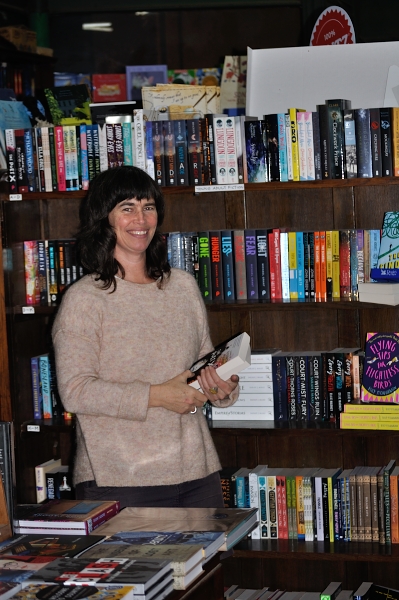
- The Poet X by Elizabeth Acevedo
A shout out to Kathryn McAllister at Stonemans Bookroom in Castlemaine, where I work. She reads a lot more YA fiction than I do, and she pushed this one into my hands. I thought I would hate this book – it’s told entirely in poetry – and yet I loved it. Xiomara (I think that’s how you say it – sounds like a Z but starts with an X) is a fifteen year old Dominican girl (Dominican Republic is in the Caribbean) living with her twin brother and parents in Harlem in NYC. It’s a rough environment, with crime, sexual harassment and violence never too far away. Her mum is a very, very religious Catholic woman, obsessed with keeping Xiomara away from bad influences. That means, mainly, boys. She’d love to have a daughter like Xiomara’s friend Caridad. Caridad is quiet, respects her parents, she can recite the Bible, she wants to wait to have sex till she’s married… But Xiomara is different. Fiesty, clever, rebellious, she fights back against the street harassment, the groping, the comments; she uses her fists to protect her brother; she defies her parents. There’s a secret and more sensitive side to this girl as well – she keeps it hidden, but she’s a poet and she wants to take part in a slam poetry competition. She also wants to get to know a boy in her class. This novel is her story…X’s voice is finally heard. I was pretty sceptical, but it’s brilliant. It says everything it needs to say, and it’s short!
I am un-hideable
Taller even than my father, with what Mami always said
was “ a little too much body for such a young girl”.
I am the baby fat that settled into D–cups and swinging hips
So that the boys who called me a whale in middle school
Now ask me to send them pictures of myself in a thong.
The other girls call me conceited. Ho…Fast.
When your body takes up more room than your voice
you are always the target of well aimed rumours,
which is why I let my knuckles talk for me…
- A Thousand Perfect Notes by C G Drews
This one is also about parental expectations… X’s mother wanted her to be a certain way; she put pressure on; she made it difficult for X to be herself, express herself, live life as herself. A Thousand Perfect Notes ramps that idea up many, many notches. 15-year-old Beck is a talented musician, but his mother – the Maestro – demands that he be a genius, a prodigy, a star performer who will carry on her shattered legacy in the musical world. No longer able to play, she teaches music at a university and forces her son to practice until his hands bleed while almost ignoring her youngest child, daughter Joey. Failing at school, Beck is paired with the unconventional August in a project. August is a sunny, kind, smart hippie-ish girl but Beck doesn’t need a friend. Because of the Maestro, he can’t afford to have a friend. But August makes Beck into the project… This is an intense, emotional, claustrophobic book, mirroring Beck’s closed-off world; the tension and drama are pumped up high almost into melodrama. It’s easy to read, absorbing, involving. C G Drews is a young Australian author.
- All the Crooked Saints by Maggie Stiefvater
I hadn’t read anything by Maggie Stiefvater, though over the years I’ve seen plenty of her novels in the shop – the Raven Boys cycle, and the Shiver books. This is a stand-alone novel.
I’m going for big contrasts here. While A Thousand Perfect Notes is claustrophobic and locked-in, with a small cast of characters, almost like a play, All the Crooked Saints is expansive.
A desert is a lot like an ocean, if you replace all of the water with air. It stretches out and out in unfathomable distance, and, in the absence of sunlight, turns to pure black. Sounds become secrets, impossible to verify as true until the light returns. It is not merely empty because we cannot see all of it. And you know in your heart that it isn’t – that it is the opposite of empty once it is dark, because things that do not like to be watched emerge when the light is gone. There is no way to know the shape of them, though, until your hand is on them.
Something was there in the desert.
The creature was moving slowly among the distant brush, dark against the night-purple horizon, nearly human-shaped. There was a rattling or hissing as it moved, like dry beans shaken gently in a pan.
This novel extends from the savage but beautiful desert setting, to the soundwaves in the air, up into the huge night sky… And another journey, into the strangeness of human beings and their hearts.
We’re in the tiny settlement of Bicho Raro in an arid area of outback Colorado, USA, in the early 1960’s. The Sorio family, originally from Mexico, are saints. Miracle workers. Pilgrims in need of a miracle turn up here and lately, have been staying around. The miracles are not quite what you’d expect. There’s a man covered in moss. A young woman who carries the weather around with her. A priest with a coyote’s head. We’re in magical realism country, with three young Soria cousins. Beatriz, Daniel and Joaquin, trying to work out their destinies. Beautiful characters, reads like a strange fairytale, gorgeous lush language. Expect music, radio, classic cars, science, roses, love, longing, despair, happiness and owls (lots of owls!)
- The Goose Road by Rowena House
World War 1, 1914-18. The Great War or the War to End All Wars. A hundred years, this November since it ended. If you think about this war – as an Australian, you might just think about Anzac Day, about the Gallipoli campaign. Or, you might think of the Western Front and the battlefields of France, where my own grandfather served. You might think of months, years of pointless-seeming protracted trench warfare, of mud, explosions, shattered minds and bodies. Red poppies, which bloomed in their millions over the buried corpses. I have to admit that, I’d not given much thought to the civilian population of France.
This novel starts on a beautiful summer’s day in 1916. 14-year-old Angelique, living on a farm in rural France, sees the postman coming. It’s the news that her father has been killed fighting for his country. Now the farm belongs to her brother, Pascal. Is he still alive? They don’t know. She and her mother have to struggle on, keeping the farm going for Pascal’s return, selling produce at the market, looking after the animals, harvesting. Bad weather, family disagreements, unpaid debts and illness all intervene, but disaster really strikes when the army requisitions (that means, simply takes) their farm animals. It seems as if they will lose everything. So Angelique decides to raise money by selling the only animals they have left – a flock of geese. To get the best price, she makes a long and difficult journey right across France. It’s a quest story. Angelique sees first hand the horrors of war. She sees the best and worst of people. She’s brave and persistent and kind. Simply told, through Angelique’s eyes – she’s an unsophisticated country girl, a peasant – this is an inspiring story. And – who knew? – geese turn out to be intelligent, affectionate and fiercely protective animals. You might even fall just a little bit in love with them. I was going to read you a very dramatic scene of an attempted goose-theft by starving peasants, involving a very angry Angelique and a rifle, but this is dramatic in another way. A goose egg…
Finally, the struggle begins again. I watch the poor little thing, slimy and dark, wiggling and twitching, constricted in the shell, too weak to break it apart.
“Come on little one. Don’t give up!”
At last, giving in to temptation, I prise open the top of the shell but I’m frightened of hurting the fragile creature inside. It seems to be nothing but a beak and two blind, bulging eyes. Then there’s another spasm of effort, a desperate convulsion, and its head flops into my lap. Instantly it seems impossible that such a big head, such a long scrawny neck, could ever have fitted inside the shell.
“Just your feet and body to go,” I whisper.
Just? The battle is too hard, the thrashing ceases. I look to the hen, but she’s fallen asleep. Clumsily I peel away fragments of the shell, chipping them off with my fingernails.
The gosling appears to be glued to the egg, to be part of it still – half born…
Tremors shake it like death throes, until one outsized webbed foot sticks up out of the shell… The bird doesn’t have the strength to push free. I breathe warm air onto it, stroking the neck with infinite tenderness.
“Fight,” I whisper. “It’s your life. Fight for it, please.”
Minutes pass, the tremors increase, then the gosling jerks, arches, the foot paddles, expands and breaks free.
“Come on!”
A claw-like wing jabs up and out. The body spills onto me, a wet bedraggled ball attached to two gigantic feet. It is the sweetest, silliest, ugliest, most beautiful thing in the world.
- Lifel1k3 by Jay Kristoff
Kristoff is a Melbourne writer. Apparently he’s 6’7” – which is around 201 cm… Anyway, he’s the author of a number of best selling titles, including The Nevernight Chronicles and The Illuminae Files. I’d never been attracted to any of these books, and thought reading this would be a bit of a chore. How wrong! This is fantastic. Fast moving, inventive, dramatic, and very, very violent! This has been such a fun read, and I’m going to go back and try his other titles.
We’re post-apocalypse which is partly environmental – the whole west coast of America has been divided by a massive shift in the San Andreas fault – and partly human made – climate change and wars between rival corporations which have trashed the country. Most of the population lives in what amounts to a megacities turned junkyards of decaying 20th century buildings, machines and technology. Everything’s rusty, dirty, gritty, greasy, wrecked, dangerous and (did I already say this?) extremely violent.
The heroine of this novel is 17-year-old Eve. Tough, funny, persistent, she lives with her grandfather; she suffers recurring nightmares of a deadly massacre which wiped out her family; and she spends her time fabricating and piloting giant robotic gladiators which battle in the WarDome arena. Which is where the novel begins. She’s “hunched on the shoulder of a metal giant”, screwdriver between her teeth, welding torch in hand, grease on her face.
“A black metal sphere sat in the socket where her right eye should’ve been. Six silcon chips were plugged behind her right ear, and a long oval of artificial flesh ran from her temple to the base of her skull. The implant obviously wasn’t made for her – the skin tone was a little too pale to match her complexion. It was just about the right shape for a nasty exit wound.”
That day in the WarDome, she loses her bout and life changes for the more interesting. Her gladiator machine is destroyed, she loses the money she needs for her grandfather’s medicine, and after she manifests the power to destroy machines with her mind, a bunch of vicious religious fanatics come after her.
What to do? Desperate for money for her grandfather, she tries a spot of scavenging when an aircraft comes down. Soon she, her “bestest” Lemon Fresh, her blitzhund Kaiser and little robot Cricket find themselves on the run with the handsome android, Ezekial that they rescued from the craft.
There’s something about Ezekial – a human-like non-human so perfect he’s called a ‘lifelike’ – that tugs at Eve’s memory. That memory that’s on the cybernetic implant. What about those nightmares? What’s real? What’s just a dream? Soon Eve doesn’t know. And she needs to find out if she’s going to survive. This is part 1; the next instalment will come out next year. Read this one now!
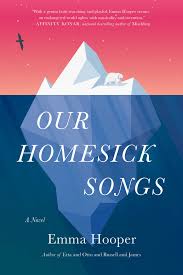 I read a lot while travelling. I bought a couple of books and then gave them away, but then there was the Kindle. I’ve always been a bit opposed, loving the physical book as I do, but for a reader on the move, it was fantastic. I loaded the complete works of Jane Austen, Anthony Trollope and Charles Dickens – a clear case of panicky stockpiling – but of course didn’t read them all. I’m not that voracious, and I think you’d need a round the world in twelve months to get that lot under your belt. But I got through Pride and Prejudice, Mansfield Park and Persuasion. And a few Canadian novels, too, which I’d bought before I left to get me in that Canadian mood. There was some crime fiction, which I consumed and then forgot, and a more memorable book called Our Homesick Songs by Emma Hooper.
I read a lot while travelling. I bought a couple of books and then gave them away, but then there was the Kindle. I’ve always been a bit opposed, loving the physical book as I do, but for a reader on the move, it was fantastic. I loaded the complete works of Jane Austen, Anthony Trollope and Charles Dickens – a clear case of panicky stockpiling – but of course didn’t read them all. I’m not that voracious, and I think you’d need a round the world in twelve months to get that lot under your belt. But I got through Pride and Prejudice, Mansfield Park and Persuasion. And a few Canadian novels, too, which I’d bought before I left to get me in that Canadian mood. There was some crime fiction, which I consumed and then forgot, and a more memorable book called Our Homesick Songs by Emma Hooper.
